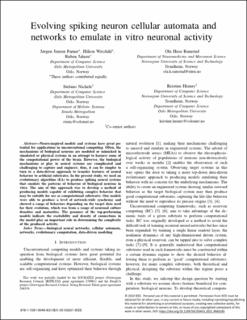| dc.contributor.author | Jensen Farner, Jørgen | |
| dc.contributor.author | Weydahl, Håkon | |
| dc.contributor.author | Jahren, Ruben | |
| dc.contributor.author | Huse Ramstad, Ola | |
| dc.contributor.author | Nichele, Stefano | |
| dc.contributor.author | Heiney, Kristine Anne | |
| dc.date.accessioned | 2022-02-11T11:57:39Z | |
| dc.date.available | 2022-02-11T11:57:39Z | |
| dc.date.created | 2021-12-06T19:27:55Z | |
| dc.date.issued | 2021-01-24 | |
| dc.identifier.isbn | 978-1-7281-9048-8 | |
| dc.identifier.isbn | 978-1-7281-9049-5 | |
| dc.identifier.uri | https://hdl.handle.net/11250/2978468 | |
| dc.description.abstract | Neuro-inspired models and systems have great potential for applications in unconventional computing. Often, the mechanisms of biological neurons are modeled or mimicked in simulated or physical systems in an attempt to harness some of the computational power of the brain. However, the biological mechanisms at play in neural systems are complicated and challenging to capture and engineer; thus, it can be simpler to turn to a data-driven approach to transfer features of neural behavior to artificial substrates. In the present study, we used an evolutionary algorithm to produce spiking neural systems that emulate the patterns of behavior of biological neurons in vitro. The aim of this approach was to develop a method of producing models capable of exhibiting complex behavior that may be suitable for use as computational substrates. Our models were able to produce a level of network-wide synchrony and showed a range of behaviors depending on the target data used for their evolution, which was from a range of neuronal culture densities and maturities. The genomes of the top-performing models indicate the excitability and density of connections in the model play an important role in determining the complexity of the produced activity. | en_US |
| dc.description.sponsorship | This work was partially funded by the SOCRATES project (Norwegian Research Council, IKTPLUSS grant agreement 270961) and the DeepCA project (Norwegian Research Council, Young Research Talent grant agreement 286558. | en_US |
| dc.language.iso | eng | en_US |
| dc.publisher | Institute of Electrical and Electronics Engineers | en_US |
| dc.relation.ispartof | IEEE Symposium Series on Computational Intelligence 2021 | |
| dc.relation.ispartofseries | IEEE Symposium Series on Computational Intelligence (SSCI);2021 IEEE Symposium Series on Computational Intelligence (SSCI) | |
| dc.relation.uri | https://arxiv.org/abs/2110.08242 | |
| dc.subject | Biological neural networks | en_US |
| dc.subject | Cellular automata | en_US |
| dc.subject | Networks | en_US |
| dc.subject | Evolutionary computation | en_US |
| dc.subject | Data-driven modeling | en_US |
| dc.title | Evolving spiking neuron cellular automata and networks to emulate in vitro neuronal activity | en_US |
| dc.type | Conference object | en_US |
| dc.description.version | publishedVersion | en_US |
| cristin.ispublished | false | |
| cristin.fulltext | original | |
| cristin.qualitycode | 1 | |
| dc.identifier.doi | https://doi.org/10.1109/SSCI50451.2021.9660185 | |
| dc.identifier.cristin | 1965299 | |
| dc.source.pagenumber | 10 | en_US |
| dc.relation.project | Norges forskningsråd: 286558 | en_US |
| dc.relation.project | Norges forskningsråd: 270961 | en_US |
